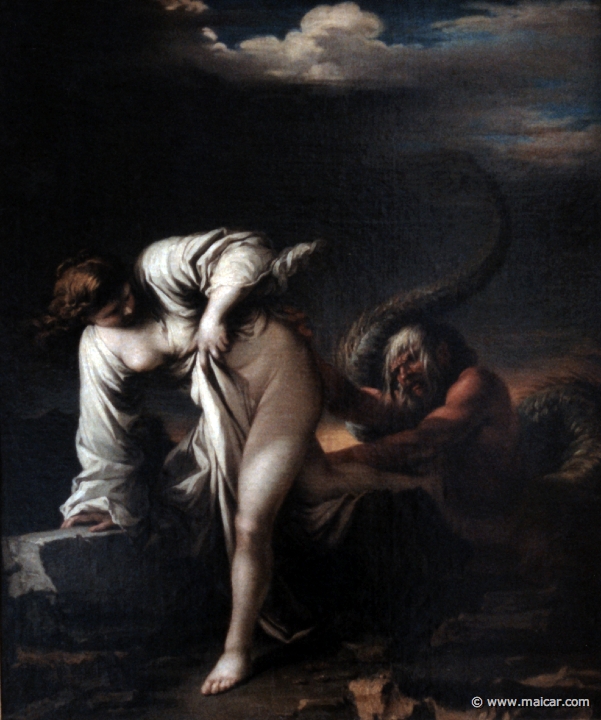|

|
4530: Rosa Salvatore 1615-1673: Glaucus et Scylla. Musée des beaux arts, Caen.
|
|
Scylla 1 is one of the monsters found on each side of the strait of Messina, between Italy and Sicily, the other being Charybdis. Scylla 1 had the face and breast of a woman, but from the flanks she had six heads and twelve feet of dogs.
Beautiful girl
Scylla 1, they say, had originally been a beautiful maiden sought by many suitors, but she scorned them all and lived with the NEREIDS, who loved her. Also Glaucus 7 fell in love with her. He is said to have been a mortal fisherman who, after chewing a plant, became a sea deity, but he is also called son of Nereus and Doris 1, being then the brother of the NEREIDS. It is
said that he changed his shape near Anthedon in the
island of Euboea, acquiring a new appearance with
amazing colours. And so he got a beard of dark
green hue, and hair covering both shoulders and
back, and his groins merged into a twisted fish
form. Not wishing any more to remain on earth, he
plunged into the sea, and being received by the
divinities of the sea, he was purged of his mortal
nature by Oceanus and
Tethys, who did this wonder with the help of magic
songs, and by bathing his body repeatedly in many
streams. But when Glaucus 7 declared her love to Scylla 1, she, not being able to decide whether he was a monster or a god, fled from him, and he, wounded by her refusal, sought Circe, hoping that this witch, with the help of her magic herbs, would make Scylla 1 to love him.
Glaucus 7 faithful to his love
Yet Circe fell herself in love with her visitor, and while advising him to scorn her who scorns, prayed instead to be herself united with Glaucus 7. But Glaucus 7 had no intentions of renouncing his love for Scylla 1. So he told the witch:
"Sooner shall
foliage grow on the sea, and sooner shall sea weeds
spring up on the mountain tops, than shall my love
change while Scylla lives." (Glaucus 7 to Circe. Ovid, Metamorphoses 14.38).
And since a woman would seldom listen to love poems addressed to some other woman, Circe, on hearing these words, was enraged. Yet she would not harm Glaucus 7, whom she loved, and instead turned her wrath upon the girl whom he loved. And so leaving her palace, Circe went to Rhegium—in the "toe" of Italy—and poisoned with drugs the water in which Scylla 1 used to bathe, so that when the girl went down into it she was transformed into a monster who was woman above, but fish from the hips down, with six dogs joined to her body.
Fate of Scylla 1
Since that time Scylla 1, from her cliff, became a pest to all sailors. And those who escaped Charybdis, who was on
the cliff on the other side of the strait, became
her victims, as occurred to several of Odysseus' companions,
whom she devoured. But some have said that at the
time when Aeneas came
with his fleet after the sack of Troy, Scylla 1 had already been changed into the dangerous rock, which still stands to this day.
Namesake: Scylla 2 was princess of Megara.
|